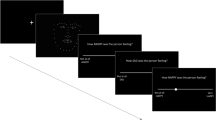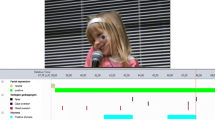Abstract
This study was designed to investigate the potential association between social anxiety and children's ability to decode nonverbal emotional cues. Participants were 62 children between 8 and 10 years of age, who completed self-report measures of social anxiety, depressive symptomatology, and nonspecific anxious symptomatology, as well as nonverbal decoding tasks assessing accuracy at identifying emotion in facial expressions and vocal tones. Data were analyzed with multiple regression analyses controlling for generalized cognitive ability, and nonspecific anxious and depressive symptomatology. Results provided partial support for the hypothesis that social anxiety would relate to nonverbal decoding accuracy. Difficulty identifying emotions conveyed in children's and adults' voices was associated with general social avoidance and distress. At higher levels of social anxiety, children more frequently mislabeled fearful voices as sad. Possible explanations for the obtained results are explored.
Similar content being viewed by others
References
Abrams, R. F. (1998). Social anxiety, social evaluative threat, and the interpretation of nonverbal displays of emotion. Unpublished doctoral dissertation, Emory University, Atlanta, Georgia.
Adalbjarnardottir, S. (1995). How schoolchildren propose to negotiate: The role of social withdrawal, social anxiety, and locus of control. Child Development, 66, 1739-1751.
Alden, L. (1987). Attributional responses of anxious individuals to different patterns of social feedback: Nothing succeeds like improvement. Journal of Personality and Social Psychology, 52, 100-106.
Archer, D., & Costanzo, M. A. (1993). The Interpersonal Perception Task-15 (IPT): A guide for researchers and teachers. Santa Cruz, CA: University of California.
Arnold, A. P., & Cheek, J. M. (1986). Shyness, self-preoccupation, and the Stroop color and word test. Personality and Individual Differences, 7, 571-573.
Asendorf, J. B. (1987). Videotape reconstruction of emotions and cognitions related to shyness. Journal of Personality and Social Psychology, 53, 542-549.
Bailey, W., Nowicki, S. Jr., & Cole, S. P. (1998). The ability to decode nonverbal information in African American, African and Afro-Caribbean, and European American adults. Journal of Black Psychology, 24, 418-431.
Baum, K. M. (1997). Emotion perception in adolescents with schizotypal personality disorder. Unpublished doctoral dissertation, Emory University, Atlanta, Georgia.
Baum, K. M., Logan, M. C., Walker, E. F., Tomlinson, H., & Schiffman, J. (1996, September). Emotion recognition in adolescents with Schizotypal Personality Disorder. Presented at the annual meeting of the Society for Research in Psychopathology, Atlanta, Georgia.
Baum, K. M., & Nowicki, S. (1997). Perception of emotion: Measuring decoding accuracy of adult prosodic cues varying in intensity. Journal of Nonverbal Behavior, 22, 89-107.
Beidel, D. C., Turner, S. M., & Morris, T. L. (1995). A new inventory to assess childhood social anxiety and phobia: The Social Phobia and Anxiety Inventory for Children. Psychological Assessment, 7, 73-79.
Chansky, T. E., & Kendall, P. C. (1997). Social expectancies and self-perceptions in anxietydisordered children. Journal of Anxiety Disorders, 11, 347-363.
Cheek, J. M., & Buss, A. H. (1982). Shyness and sociability. Journal of Personality and Social Psychology, 41, 330-339.
Collins, M. (1996). Personality and achievement correlates of nonverbal processing ability in African-American children. Unpublished doctoral dissertation, Emory University, Atlanta, Georgia.
Crick, N. R., & Dodge, K. A. (1994). A review and reformulation of social informationprocessing mechanisms in children's social adjustment. Psychological Bulletin, 115, 74-101.
Crick, N. R., & Ladd, G. W. (1993). Children's perceptions of their peer experiences: Attributions, loneliness, social anxiety, and social avoidance. Developmental Psychology, 29, 244-254.
Custrini, R. J., & Feldman, R. S. (1989). Children's social competence and nonverbal encoding and decoding of emotions. Journal of Clinical Child Psychology, 18, 336-342.
DePaulo, B. M., & Tang, J. (1994). Social anxiety and social judgment: The example of detecting deception. Journal of Research in Personality, 28, 142-153.
Edwards, R., Manstead, A. S. R., & MacDonald, C. J. (1984). The relationship between children's sociometric states and ability to recognize facial expressions of emotion. European Journal of Social Psychology, 14, 235-238.
Epkins, C. C. (1996). Cognitive specificity and affective confounding in social anxiety and dysphoria in children. Journal of Psychopathology and Behavioral Assessment, 18, 83-101.
Ginsburg, G. S., La Greca, A. M., & Silverman, W. K. (1998). Social anxiety in children with anxiety disorders: Relation with social and emotional functioning. Journal of Abnormal Child Psychology, 26, 175-185.
Goonan, L. J. (1994). Social competence in preschool children. Unpublished doctoral dissertation, Emory University, Atlanta, Georgia.
Gotlib, I. H., & Hammen, C. L. (1992). Psychological aspects of depression: Toward a cognitive-interpersonal integration. London: Wiley.
Kaufman, A. S., & Kaufman, N. L. (1990). Kaufman Brief Intelligence Test Manual. Circle Pines, MN: American Guidance Service.
Kovacs, M. (1982). The Children's Depression Inventory: A self-rating depression scale for school-aged youngsters. Unpublished manuscript, University of Pittsburgh.
La Greca, A. M., Dandes, S. K., Wick, P., Shaw, K., & Stone, W. L. (1988). Development of the Social Anxiety Scale for Children: Reliability and concurrent validity. Journal of Clinical Child Psychology, 17, 84-91.
La Greca, A. M., & Lopez, N. (1998). Social anxiety among adolescents: Linkages with peer relations and friendships. Journal of Abnormal Child Psychology, 26, 83-94.
La Greca, A. M., & Stone, W. L. (1993). Social Anxiety Scale for Children-Revised: Factor structure and concurrent validity. Journal of Clinical Child Psychology, 22, 17-27.
Maxim, L., & Nowicki, S. (1996, April). Social competence associated with nonverbal receptive processing ability for three different age groups. Poster presented at the annual meeting of the Southeastern Psychological Association, Atlanta, Georgia.
McClanahan, P. (1996). Social competence correlates of children who are 7 and 8 years of age. Unpublished master's thesis, Department of Psychology, Emory University, Atlanta, GA.
Mumley, D. (1995). Gender differences in depressive realism: The roles of nonverbal decoding ability and relational self-concept. Unpublished doctoral dissertation, Emory University, Atlanta, Georgia.
Nowicki, S. (1995). A study of the DANVA-AV in college students. Unpublished manuscript, Emory University, Atlanta, Georgia.
Nowicki, S. & Carton, J. (1993). The measurement of emotional intensity from facial expressions.
Nowicki, S., & Duke, M. (1989). A measure of nonverbal social processing ability in children between the ages of 6 and 10. A paper presented at the Annual Meeting of the American Psychological Society, Alexandria, VA.
Nowicki, S., & Duke, M. P. (1992). The association of children's nonverbal decoding abilities with their popularity, locus of control, and academic achievement. Journal of Genetic Psychology, 153, 385-394.
Nowicki, S., & Duke, M. P. (1994). Individual differences in the nonverbal communication of affect: The Diagnostic Analysis of Nonverbal Accuracy Scale. Special Issue: Development of nonverbal behavior: II. Social development and nonverbal behavior. Journal of Nonverbal Behavior, 18, 9-35.
Nowicki, S. Jr., & Mitchell, J. (1997). Accuracy in identifying affect in child and adult faces and voices and social competence in preschool children. Genetic, Social, and Psychological Monographs, 124, 39-59.
Nowicki, S. Jr., & Strand, K. K. (in press). Receptive nonverbal processing ability and locus of control orientation in conduct disordered children and adolescents. Behavior Disorders.
Patterson, M. L. (1995). A parallel process model of nonverbal communication. Journal of Nonverbal Behavior, 19, 3-29.
Pilkonis, P. A. (1977). Shyness, public and private, and its relationship to other measures of social behavior. Journal of Personality, 45, 585-595.
Reynolds, C. R., & Richmond, B. O. (1985). Revised Children's Manifest Anxiety Scale: Manual. Los Angeles: Western Psychological Corporation.
Rowe, E. E. (1996). Children's sociometric status: Sex differences in the correlates of peer acceptance and rejection. Unpublished doctoral dissertation, Department of Psychology, Emory University, Atlanta.
Saylor, C. F., Finch, A. J., Spirito, A., & Bennett, B. (1984). The Children's Depression Inventory: A systematic evaluation of psychometric properties. Journal of Consulting and Clinical Psychology, 52, 955-967.
Schroeder, J. E. (1995). Self-concept, social anxiety, and interpersonal perception skills. Personality and Individual Differences, 19, 955-958.
Schroeder, J. E., & Ketrow, S. M. (1997). Social anxiety and performance in an interpersonal perception task. Psychological Reports, 81, 991-996.
Spence, S. H. (1987). The relationship between social-cognitive skills and peer sociometric status. British Journal of Developmental Psychology, 5, 347-356.
Stewart, S. L., & Rubin, K. H. (1995). The social problem-solving skills of anxious-withdrawn children. Development and Psychopathology, 7, 323-336.
Strauss, C. C., Frame, C. L., & Forehand, R. (1987). Psychosocial impairment associated with anxiety in children. Journal of Clinical Child Psychology, 16, 235-239.
Strauss, C. C., Lahey, B. B., Frick, P., Frame, C. L., & Hynd, G. W. (1988). Peer social status of children with anxiety disorders. Journal of Consulting and Clinical Psychology, 56, 137-141.
Verbeek, P. (1996). Peacemaking in young children. Unpublished doctoral dissertation, Emory University, Atlanta, Georgia.
Vosk, B. N., Forehand, R., & Figueroa, R. (1983). Perception of emotions by accepted and rejected children. Journal of Behavioral Assessment, 5, 151-160.
Wagner, H. L. (1997). Methods for the study of facial behavior. In J. A. Russell & J. M. Fernandez-Dols (Eds.) The Psychology of Facial Expression (pp. 31-56). Cambridge, England: Cambridge University Press.
Watson, D., & Clark, L. A. (1984). Negative affectivity: The disposition to experience aversive emotional states. Psychological Bulletin, 96, 465-490.
Wierzbicki, M., & McCabe, M. (1988). Social skills and subsequent depressive symptomatology in children. Journal of Clinical Child Psychology, 17, 203-208.
Winton, E. C., Clark, D. M., & Edelmann, R. J. (1995). Social anxiety, fear of negative evaluation and the detection of negative emotion in others. Behavior Research and Therapy, 33, 193-196.
Zuckerman, M., & Przewuzman, S. J. (1979). Decoding and encoding facial expressions in preschool-aged children. Environmental Psychology and Nonverbal Behavior, 3, 147-163.
Author information
Authors and Affiliations
Corresponding author
Rights and permissions
About this article
Cite this article
McClure, E.B., Nowicki, S. Associations Between Social Anxiety and Nonverbal Processing Skill in Preadolescent Boys and Girls. Journal of Nonverbal Behavior 25, 3–19 (2001). https://doi.org/10.1023/A:1006753006870
Issue Date:
DOI: https://doi.org/10.1023/A:1006753006870




